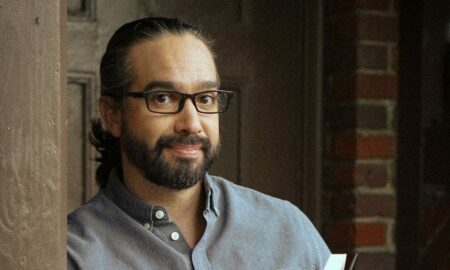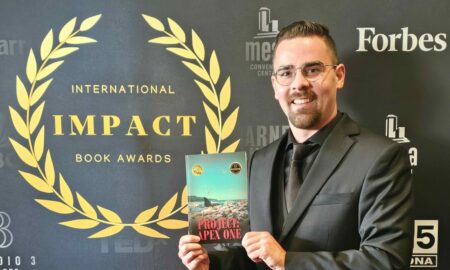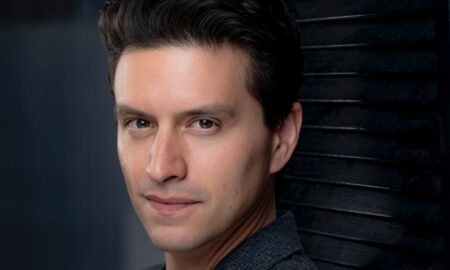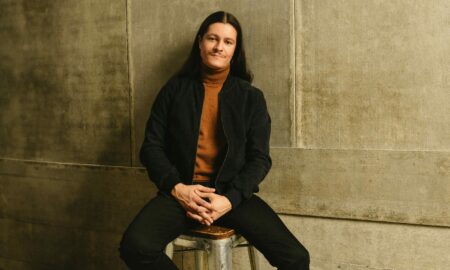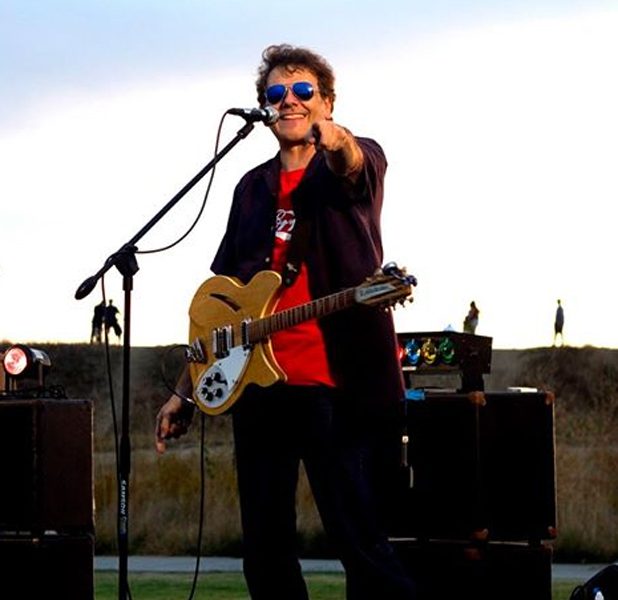

Today we’d like to introduce you to Lorenzo Gigliotti.
Lorenzo, please share your story with us. How did you get to where you are today?
My nome d’arte is “LorenzoLorenzoLorenzo”.
I created my first band at age eleven, with my cousin Giovanni and two of my school-friends from Torrance Elementary. We called our band “Hot Ice” — somehow we managed to learn a couple of hours worth of songs by the Beatles, the Rolling Stones, the Byrds and a few more 60s artists — we got a couple of paying gigs almost immediately. We were “professionals!” I had begun taking guitar lessons when I was seven years old and can honestly say that I was not a child prodigy. It took me three years to actually understand what I was learning, but once I did, I couldn’t stop playing and eventually writing songs.
I began playing 12-string guitar at age 12 and never wanted to play anything else — to this day, I still play 12-string exclusively. I just love the “jingle-jangle”, the rich-full sound, and the layers upon layers of frequencies that emanate from the vibrations of so many strings in harmony. At times the harmonics take on an ethereal quality that sounds orchestral — I often hear wind instruments, bowed instruments and keyboards in the jingle-jangle or the drone of the 12-string’s harmonics. This is the instrument that allows me to express myself — it is incredibly easy for me to hear new songs when I pick it up and experiment with scales or chord combinations. Melodies just seem to form from the ether while the instrument’s audio textures suggest so many moods. Within the echoing tones, the lyrics just emerge — the songs simply come together as though they were always there, and I am just fine-tuning them or releasing them.
As the years progressed, several bands, came and went until — years later Tim Chaplin (my high school buddy) and I formed the band “Jupiter” — it was 1976, Tim and I had already been in a couple of bands together but Jupiter was “gonna be different.” We were going to make this one work. In 1977 — a year and three drummers later, we still needed a “real” drummer. Luckily for us, Jay Perris came into our lives and for some reason, this amazing percussionist wanted to perform with us — almost like he took us under his wing. Jay was way out of our league at the time. Understand that I was a decent guitar-player and Tim was a good bass player but unlike either of us, Jay had been a child-prodigy and could play with anyone — but he heard something in our sound that made him interested in working with us and he showed us how to really make music.
By 1980, our power-trio began performing up and down the Sunset Strip and throughout southern California playing sets of our original material in some of the most famous clubs of the era. LA was ground-zero for New Wave / Punk. KROQ radio became the #1 station at the forefront of the new genre explosion. We got airplay on KROQ and even became part of their regular rotation. For a while, Jupiter was also KROQ’s featured band at Gazzari’s On The Strip, as well as Costa Mesa’s “notorious” Cuckoos Nest and even at Doug Weston’s “World Famous Troubadour.” In our hometown, Long Beach, California, we performed at The Lafeyette Ballroom (aka Fender’s Ballroom) and had two outdoor shows at CSULB. Jupiter even did a few a week at Long Beach’s notorious biker-bar “The Hardrock Saloon” — long before it became today’s Alex’s Bar.
We self-financed, self-produced and self-distributed our 1980s album “Multiple Choice” which now 30+ years later has become extremely sought after by collectors — it didn’t go “Platnum”, “Gold” or “Silver” at the time — we liked to say it went “RUST” but in a strange twist of the universe, a mint condition “Mulitple Choice” album did fetch $250 on the world collector market — collectors sometimes refer to Jupiter as “Long Beach’s Proto Punk Supergroup” — IMPORTANT NOTE “proto punk” is not “punk” but is a term used to describe the elements that influenced punk music — proto punk is music which is more reminiscent of the 1960’s and New Wave-style Pop Rock. You can still find copies of the album on Amazon and Ebay — prices vary from around $50 to $200 depending on condition and demand — I think of it like a bit-coin.
For many artists, creating and performing music is a passion, not a hobby, not a pastime. It is a part of the artist, and the artist is going to create it and perform it regardless of whether or not anyone else cares. But on a more practical level, it would be pure joy to be able to support one’s self and loved ones, by only creating and performing music, but as I said — many, if not most artists’ music will happen regardless of whether or not it can provide a living. I have asked other artists — “if your art cannot support you (financially), are you willing to support your art?” I mean “would you do whatever you need to do so that you can still create your art.” The answer from almost every artist that I know has been “yes.” That’s why so many artists toil away at mundane “day-jobs” that often are little more than a paycheck. Even artists that are very, very well-known will do whatever they need to in order to make sure that they can buy the tools of their discipline, as well as take care of those who are dear to them. It’s no surprise to me that I often hear an artist who has just returned from three or four months as a support-artist on a significant tour lament — “…now that I’m home I guess I gotta go back to work (in the office or the store)…” where they work the rest of the time to actually keep a roof over their family.
The path of life is mysterious and often, we don’t know exactly where anything will lead, but things happen, priorities change and sometimes we are tested… suffice it to say — I left music in 1986 and took a couple of decades to devote myself to taking care and raising my family in a more regular-paying, traditional manner.
Now fast-forward to the Spring of 2015. At the behest of family and friends, Jay and I reinvented Jupiter as a duo-band, “Jupiter 2.0” and added new material to our catalog. Right out-of-the-box, we were able to pick up where we left off — playing three-hour shows as if it was still 1985. Jupiter’s most recent album “Destiny, Free-Will and Chaos” was voted one of the top Long Beach albums of 2015 in the Long Beach Post’s “Best Long Beach Album” category — it managed to achieve this, despite the album unofficially being released only a week prior to poll-voting. Since the rebirth, Jupiter 2.0 has maintained a very active concert schedule performing throughout the southern California area — and the performances continue into the present. However…
In late 2016 Jay returned to his personal projects. He plays guitar and is lead vocalist with his band The Rumble. I have been fortunate to be able to keep Jupiter 2.0 alive and well, with the aid of Travis Christopherson who is an amazingly talented percussionist and vocalist who has somehow managed to step into the role of providing a backbeat as well as vocal-harmony for Jupiter 2.0 — his style makes it possible for the Jupiter-sound to continue on.
As I mentioned before — “Jupiter 2.0 is a duo band” — we are able to flood a room with layers of sound, not by volume but with sound — lows, highs, bottom beats, percussive-bass and vocals — we produce the sound of a larger band. After a show, we love it when people tell us they could not believe that only two musicians produced the sound of a full band. Jupiter 2.0 has performed hundreds of shows over the last five years and plans are in the works to record another album and do many, many more live shows or live-streams.
We’re always bombarded by how great it is to pursue your passion, etc – but we’ve spoken with enough people to know that it’s not always easy. Overall, would you say things have been easy for you?
It has been one heck of a roller-coaster ride. There were times when everything would fall into place with no resistance. Other times it felt like obstacle upon obstacle would be placed in the path. Here are few examples.
Recording
We recorded the “Multiple Choice” album for $1000.00. A thousand dollars did not buy much recording time in 1979 but we found “Media Arts” — a great little studio in Hermosa Beach, Ca. They let us use their studio for an incredibly discounted rate as long as we booked recording blocks after midnight. Recording was much different than it is today. Now a decent computer, a half dozen quality microphones and some audio software allow artists the opportunity to digitally record at home.
Distribution and Air-Play
We could not find a distributor to get our record into record stores. We were little fish in a huge pond and without distribution, we could not get radio-play. The radio stations would tell us — “if it’s not in the stores then we can’t play it” at the same time distributors were saying “if you’re not getting air-play then we’re not interested in distributing it. So Jay and I distributed the album ourselves. We literally drove to every independent record store from the San Fernando Valley down to San Clemente and cajoled them into carrying the album. We also brought a couple of dozen to the Tower Records store on Sunset Blvd. The manager at that store was enthusiastic and encouraging. He said they wanted everything that was new and accepted our delivery. He even told us how to get it into the other Tower stores. He told us to call the main office and talk to the purchasing “lady” and ask her for a vendor number. We did that and voila, we could then drop off a stack at any Tower store without any problem. I loved Tower Records for this. By the time we finished distributing the records, we had Jupiter’s “Multiple Choice in over 40 record stores and Tower Records — not bad for a bunch of kids with no representation or any industry connections. This paved the way for us to get KROQ to talk to us and they gave us a shot and put our album in their playlist rotation. We even bought commercials on KROQ to help promote the album. Eventually, our efforts paid off and KROQ also began using us to perform at their events — for a little while, we were also KROQ’s “goto band” filling in for scheduled-bands who could not make it to their KROQ event. Today artists can self-promote using internet media and social media platforms such as YouTube, Facebook, Instagram and Twitter. There were no such things before.
Booking shows… the straw that broke this camel’s back
As the 1980s progressed, we began experiencing more and more difficulty with booking agents, club owners and promoters. Times were changing — demand for bands started to wane and eventually more and more shows were getting canceled at the last minute. It was frustrating and it made me read the writing on the wall so-to-speak. I was married and had a young son. My wife and I wanted a couple more kids but there was no way that I could see music paying our bills, so I went into exile from the business and raised a beautiful family. I knew the music was inside me but my priorities were family-first.
These are just a few examples of the challenges that we encountered. When I returned to music in 2014, some things were better, while others were the same or even worse.
Can you give our readers some background on your music?
I am an artist seeking to make a decent living entertaining audiences and sharing my art.
Jupiter and Jupiter 2.0 are performance entities to help me and my collaborators make music and present it to the general public.
Below is a list of musicians who have been part of the lineup.
Lorenzo Gigliotti aka Lorenzo Lorenzo Lorenzo (1976-present)
— Vocals, Guitar & Bass simultaneously
Jay Perris
— Vocals, Electronic Drums, Percussion, e-Drum Bass (1977-2017)
Tim Chaplin
— Vocals, Bass Guitar, Guitar (1976-1982)
Travis Christopherson
— Vocals, Drums, Saxophone, Percussion, e-Drum Bass (2017-present)
Note – Jupiter 2.0 also periodically works with the dance group Maha & Company — which adds choreography and interpretive dancing into Jupiter 2.0 performances.
What were you like growing up?
As a child, I was a little on the shy side but I always felt a need to express myself in some way. It took a great deal of work for the young me to get to a point where I was at ease performing in front of people.
I was also very curious — I wanted to know how things worked so it was not unusual to find me taking something apart and then putting it back together.
I had an older sister who controlled the radio, so I grew up listening to a great deal of 1960s rock which still influences my work.
My parents were both born in Italy and immigrated to the USA. They had quite a collection of 78 rpm records ranging from a variety of Italian music including opera, Italian folk songs and standards to Elvis Presley, Johnny Cash, Dean Martin, Harry James, Dinah Shore, Louis Armstrong, etc.
Every Sunday morning, they would put a stack of those records on the phonograph auto-changer and let them play for hours. Many, many of these songs are ingrained in my memory. I can still hear them in my head and their musical structures have influenced many of my original compositions — elements of Italian, Spanish, North African and middle-eastern music can all be heard in my songs.
Contact Info:
- Website: http://www.Jupitermax.com
- Phone: 5628991042
- Email: interg@aol.com
- Facebook: https://www.facebook.com/originaljupiterband/
https://www.facebook.com/pg/originaljupiterband/videos/ - Twitter: @lorenzgigliotti
- Other: YouTube – https://www.youtube.com/playlist?list=PLY1EzVDQQaXCzYSR8ZGhgbpw0iYYsxH8z








Image Credit:
Michael Kelleher, Diana Perkins, Richard Shimizu, Jo Hanna Hernandez, Lena Gigliotti
Suggest a story: VoyageLA is built on recommendations from the community; it’s how we uncover hidden gems, so if you or someone you know deserves recognition please let us know here.














